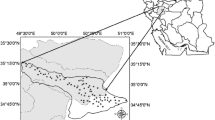Abstract
The SINTACS approach was used to evaluate intrinsic groundwater vulnerability within Nong Rua District, Khon Kaen Province, Thailand. The approach is based on seven environmental variables prepared in the form of GIS data layers. These variables are depth to water level, infiltration capacity, unsaturated zone, soil type, aquifer media, hydraulic conductivity, and slope. The resulting vulnerability map depicts the spatial extent of six classes of vulnerability ranging from very low to extremely high. High and moderate level classes of vulnerability dominated most of the study area. The northwestern, southwestern and central parts of the study area fell under the very high and extremely high vulnerability levels according to this approach. These regions displayed characteristics that indicated their vulnerability such as a high infiltration rate, coarse-texture soil, and shallow depth to groundwater. The statistical correlation coefficient between the nitrate concentration in 87 wells and the SINTACS vulnerability levels was 0.51. Both map removal and single variable sensitivity analyses were performed to observe the influence of specific variables on the model result. The result of this study is useful for guiding strategic planning of groundwater quality management.









Similar content being viewed by others
References
Al Kuisi M, El-Naqa A, Hammouri N (2006) Vulnerability mapping of shallow groundwater aquifer using SINTACS model in the Jordan valley area, Jordan. Environ Geol 50:651–667. doi:10.1007/s00254-006-0239-8
Al-Amoush H, Hammouri NA, Zunic F, Salameh E (2010) Intrinsic vulnerability assessment for the alluvial aquifer in the northern part of Jordan valley. Water Res Manage 24:3461–3485. doi:10.1007/s11269-010-9615-y
Aller L, Bennet T, Lehr JH, Petty RJ, Hacket G (1987) DRASTIC: a standardized system for evaluating ground water pollution potential using hydrogeologic settings. US Environmental Protection Agency Report (EPA/600/2-87/035), Robert S. Kerr Environmental Research Laboratory, p 455
Babiker IS, Mohamed MAA, Hiyama T, Kato K (2005) A GIS-based DRASTIC model for assessing aquifer vulnerability in Kakamigahara Heights, Gifu Prefecture, central Japan. Sci Total Environ 345:127–140. doi:10.1016/j.scitotenv.2004.11.005
Catchment L (2001) Groundwater vulnerability map explanatory notes. NSW Department of Land and Water Conservation. Parramatta, NSW, p 14
Civita M (1994) Le Carte della vulnerabilità degli acquiferi all’inquinamento. Teoria and practica. Pitagora Editrice, Bologna, p 325
Civita M, De Maio M (1997) SINTACS. Un sistema parametrico per la valutazione e la cartografia della vulnerabilita` degli acquiferi all’inquinamento. Metodologia and Automatizzazione, vol. 60. Pitagora Editrice, Bologna, p 191
Civita M, De Maio M (2000) Valutazione e cartografia automatica della vulnerabilità degli acquiferi all’inquinamento con il sistema parametrico SINTACS R5: a new parametric system for the assessment and automatic mapping of ground water vulnerability to contamination. Pitagora Editrice, Bologna, p 240
Civita M, De Maio M (2004) Assessing and mapping groundwater vulnerability to contamination: the Italian “combined” approach. Geofísica Int 43(4):513–532
Hentati I, Zairi M, Dhia HB (2010) A statistical and geographical information system analysis for groundwater intrinsic vulnerability: a validated case study from Sfax–Agareb, Tunisia. Water Environ J 1–12. doi:10.1111/j.1747-6593.2010.00235.x
Foster SSD (1987) Fundamental concepts in aquifer vulnerability, pollution risk and protection strategy. In: Van Duijvenbooden W, Van Waegeningh HG (eds) TNO committee on hydrological research. Vulnerability of soil and groundwater to pollutants, proceedings and information, vol 38. The Netherlands, The Hague, pp 69–86
Linsley RK, Kohler MA, Paulhus JLH (1988) Hydrology for Engineers. McGraw-Hill, Singapore
Napolitano P, Fabbri AG (1996) Single-parameter sensitivity analysis for aquifer vulnerability assessment using DRASTIC and SINTACS. In Proceedings of Vienna Conference, IAHS Publ. 235, Wallingford, pp 559–566
National Research Council (NRC) (1993) Groundwater vulnerability assessment: predictive relative contamination potential under conditions of uncertainty. National Academy Press, Washington, DC
Ong’or BTI, Long-cang S (2007) Groundwater overdraft vulnerability and environmental impact assessment in Arusha. Environ Geol 51:1171–1176. doi:10.1007/s00254-006-0408-9
Phetprayoon T, Sarapirome S, Navanugraha C, Wonprasaid S (2009) Surface runoff estimation using grid-based curve number method in the upper Lam Phra Phloeng Watershed, Thailand. In 30th Asian conference on remote sensing, 18–23 October 2009, Beijing, China
Rapti-Caputo D, Sdao F, Masi S (2006) Pollution risk assessment based on hydrogeological data and management of solid waste landfills. Environ Geol 85:122–131. doi:10.1016/j.enggeo.2005.09.033
Sarapirome S, Majandang J (2008) Groundwater vulnerability mapping using a GIS-based DRASTIC model at Lam Takhong Subbasin, Nakhon Ratchasima, Thailand. In: Proceedings of the international symposia on geoscience resources and environments of Asian terranes (GREAT 2008), 4th IGCP 516, and 5th APSEG. Bangkok, pp 559–564
Soil Conservation Service (SCS) (1985) National engineering handbook. Section 4-Hydrology. U.S. Department of Agriculture, Washington, DC
U.S. Department of Agriculture (1986) Urban hydrology for small watersheds. U.S. Department of Agriculture, Washington, DC
Van Stempoort D, Ewert L, Wassenaar L (1993) Aquifer vulnerability index: a GIS compatible method for groundwater vulnerability mapping. Can Water Res J 18:25–37
Vrba J, Zaporozec A (1994) Guidebook on mapping groundwater vulnerability. International Contributions to Hydrogeology, vol 16. International Association of Hydrogeologists, Heise Hannover, p 131
Acknowledgments
This research was granted by the Commission on Higher Education granting through Mr. Jiradech Majandang who was funded under the CHE-PHD-THA program.
Author information
Authors and Affiliations
Corresponding author
Rights and permissions
About this article
Cite this article
Majandang, J., Sarapirome, S. Groundwater vulnerability assessment and sensitivity analysis in Nong Rua, Khon Kaen, Thailand, using a GIS-based SINTACS model. Environ Earth Sci 68, 2025–2039 (2013). https://doi.org/10.1007/s12665-012-1890-x
Received:
Accepted:
Published:
Issue Date:
DOI: https://doi.org/10.1007/s12665-012-1890-x




